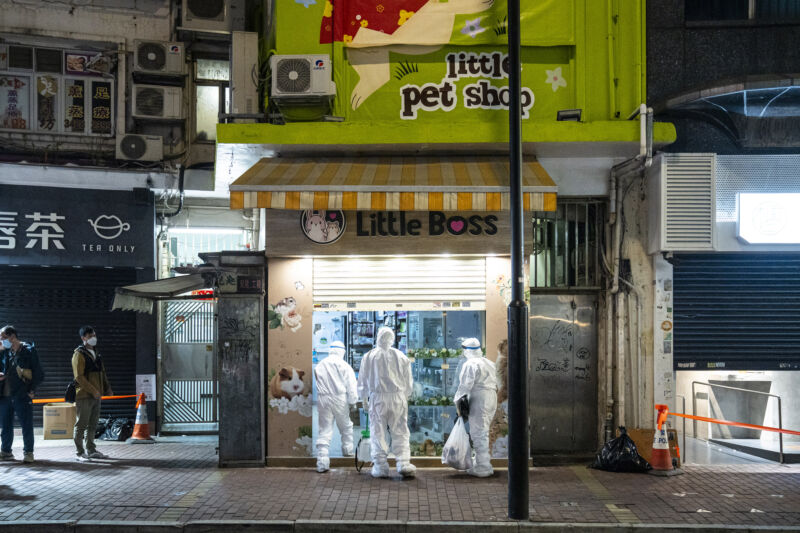
Authorities in Hong Kong are planning to cull around 2,000 small animals after a pet store employee and several imported hamsters tested positive for COVID-19, according to a report by the Associated Press.
On Monday, the pet store employee tested positive and was found to be infected with the delta coronavirus variant. Several hamsters in the store, which had recently been imported from the Netherlands, were also positive. The city, meanwhile, has been grappling with an outbreak of COVID-19 cases caused by the omicron variant.
It's unclear if the pet store cases are linked and, if they are, if the employee was infected by the hamsters or vice versa. But Hong Kong authorities say they can't exclude the possibility that the hamsters spread the virus to the employee. As such, they aren't taking any chances.
Hamster havoc
Authorities halted all sales of hamsters in the city as well as the import of hamsters and other small animals, such as chinchillas. Around 2,000 small animals already in Hong Kong will be humanely culled to prevent transmission of the pandemic virus.
Meanwhile, people who bought pet hamsters in the city since December 22 must undergo testing. If their pets test positive, they must go into quarantine.
At a news conference, Hong Kong health official Leung Siu-fai advised: "If you own a hamster, you should keep your hamsters at home, do not take them out. All pet owners should observe good personal hygiene, and after you have been in contact with animals and their food, you should wash your hands." He also advised owners to "not kiss your pets."
In a press briefing Tuesday, officials with the World Health Organization addressed the hamster cases, saying that "the risk remains low" that animals are getting infected from people and then transmitting the virus back to people at significant rates.
"But it is something that we are constantly looking at," Maria Van Kerkhove, the WHO's COVID-19 technical lead, said in the briefing. As the virus circulates, it can continue to infect people and animals, "so this is something we need better surveillance on."
It's already clear that many animal species can become infected with SARS-CoV-2 and potentially serve as a reservoir for variants that could threaten to jump back to humans at any time. In 2020, Denmark's government made the controversial decision to cull 17 million mink after the farmed animals were found to harbor a SARS-CoV-2 variant.
Animal reservoirs
In the US, several studies have documented widespread SARS-CoV-2 transmission in wild deer populations, as well as in farmed mink. Domesticated pets, such as dogs and cats, are known to be at risk of getting COVID-19 from their owners. Some zoo animals are equally at risk.
For now, health officials are more focused on transmission of SARS-CoV-2 among people. But there is bubbling concern about animal reservoirs, particularly amid the rise of omicron. The ultratransmissible variant quickly raised concern among experts because it first appeared with a startlingly large number of mutations—many of which had not previously been seen in variants known to be circulating in humans.
Omicron's sudden appearance raised concerns—and hypotheses—that the variant originated in an animal reservoir, specifically mice. The thinking goes that humans had spread SARS-CoV-2 to wild mice, which then circulated the virus over a period of time. There, the virus adapted to its new host and picked up a variety of novel mutations before jumping back to humans.
For now, it's just a hypothesis—and not necessarily the leading one. Many researchers say that a more likely explanation for omicron's origin is an immunocompromised person. In this scenario, an immunocompromised person may have harbored an infection over a long period. That gave the virus plenty of time to be exposed to various feeble immune responses and adapt to avert them, thereby evolving into a more dangerous foe to humans overall. Such prolonged infections in immunocompromised people are the leading hypotheses for the development of new variants in general.
But the latest concerns over pet hamsters is likely to keep some attention on the potential threat of animal reservoirs of the pandemic virus.
World - Latest - Google News
January 19, 2022 at 06:10AM
https://ift.tt/3FG5yaE
COVID-infected hamsters in pet shop trigger animal cull in Hong Kong - Ars Technica
World - Latest - Google News
https://ift.tt/2SeTG7d
https://ift.tt/35oCZy1
Bagikan Berita Ini















0 Response to "COVID-infected hamsters in pet shop trigger animal cull in Hong Kong - Ars Technica"
Post a Comment